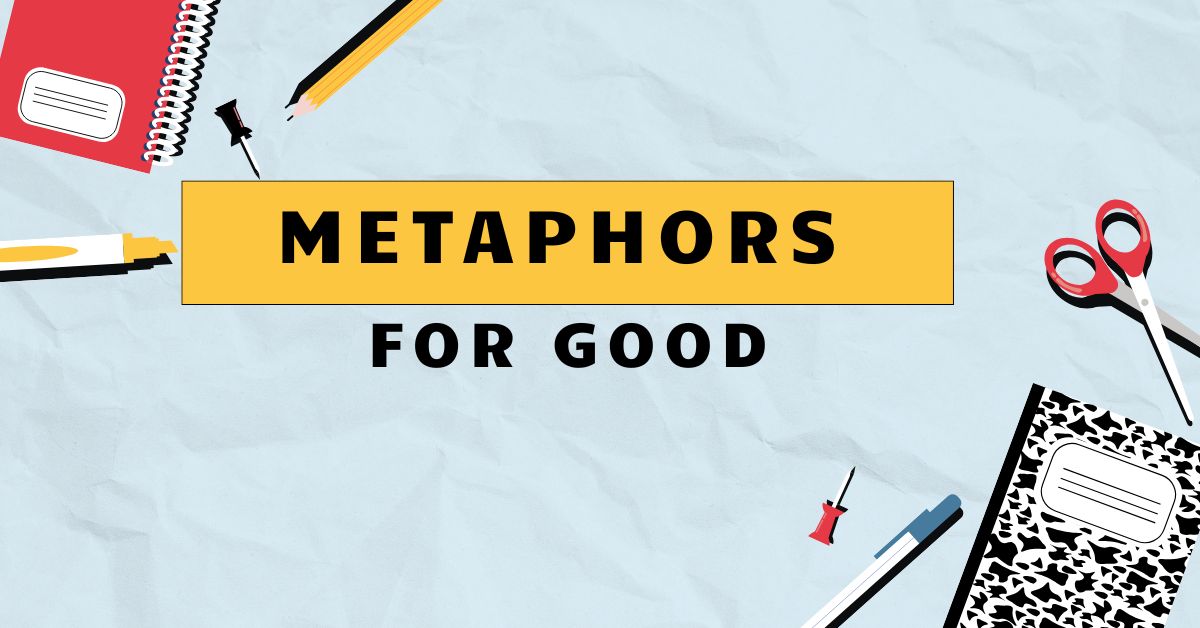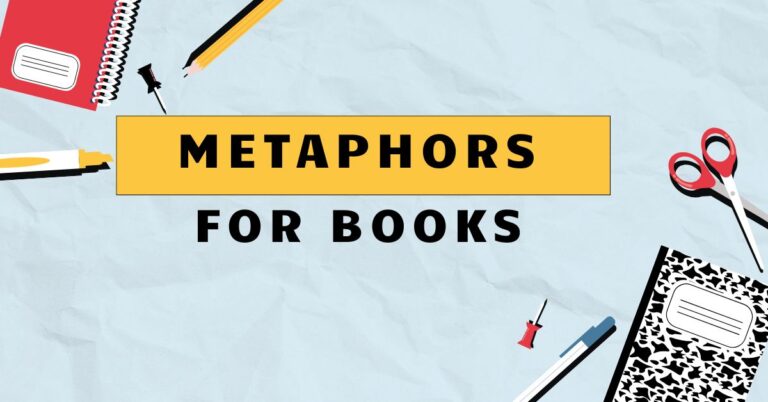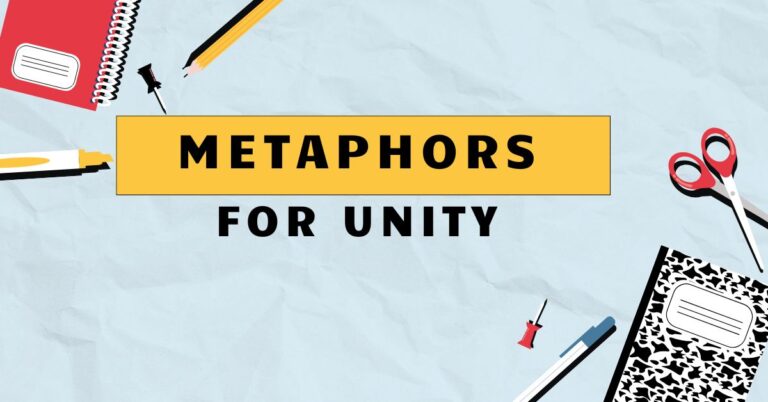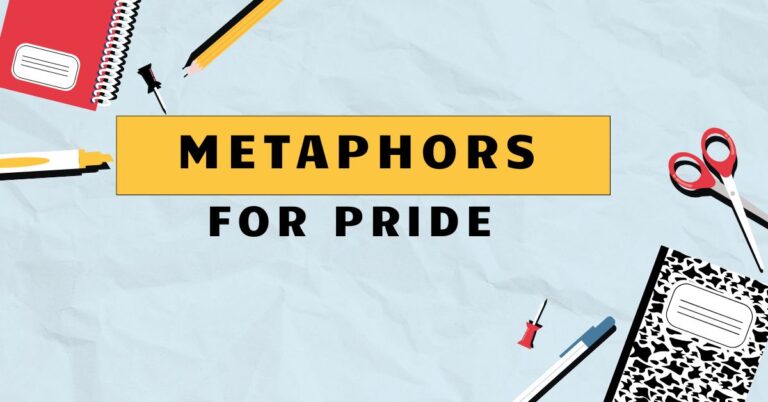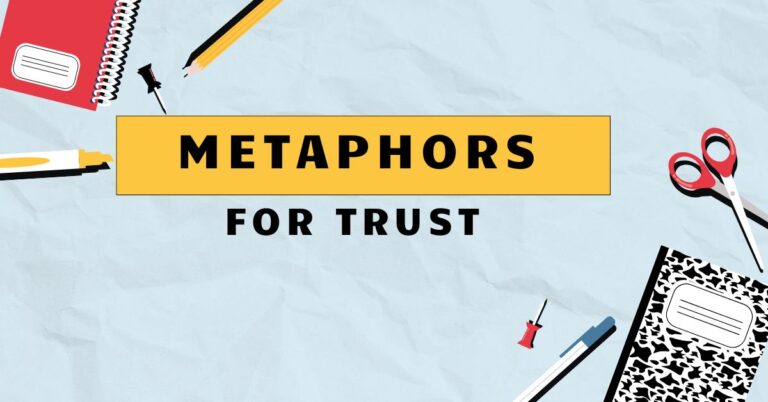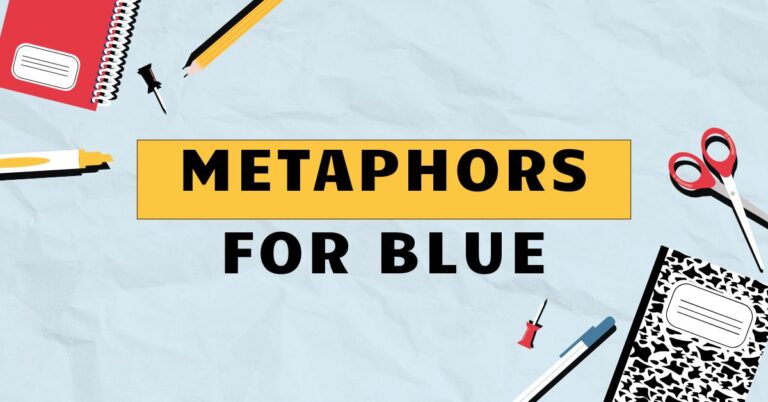47 Metaphors For Good: Enhancing Language and Understanding
Metaphors are powerful figures of speech that enrich our language and understanding by drawing comparisons between seemingly unrelated things. They allow us to convey complex ideas and emotions in a vivid and memorable way, transforming ordinary language into something extraordinary.
Understanding metaphors is crucial for interpreting literature, engaging in effective communication, and appreciating the nuances of human expression. This article will delve into the world of metaphors, exploring their definition, structure, types, and usage, providing you with the tools to master this essential linguistic device.
Whether you are a student studying literature, a writer seeking to enhance your craft, or simply someone who wants to improve their communication skills, this comprehensive guide will provide you with a solid foundation in the art of using metaphors effectively. We will cover everything from basic definitions to advanced techniques, equipping you with the knowledge and practice you need to confidently identify, analyze, and create compelling metaphors.
Table of Contents
- Definition of Metaphor
- Structural Breakdown of Metaphors
- Types of Metaphors
- Examples of Metaphors
- Usage Rules for Metaphors
- Common Mistakes with Metaphors
- Practice Exercises
- Advanced Topics in Metaphors
- Frequently Asked Questions
- Conclusion
Definition of Metaphor
A metaphor is a figure of speech that directly compares two unrelated things without using “like” or “as.” It asserts that one thing *is* another, creating a connection that illuminates a shared quality or characteristic. This comparison is not literal but rather figurative, inviting the reader or listener to understand one concept in terms of another.
The power of a metaphor lies in its ability to transfer meaning and evoke vivid imagery, making language more engaging and impactful.
The function of a metaphor is to provide a new perspective on a subject, enhance understanding, and add depth to communication. By drawing parallels between dissimilar entities, metaphors can simplify complex ideas, making them more accessible and relatable.
They also add emotional resonance and aesthetic appeal to writing and speech. Metaphors are ubiquitous in everyday language, literature, poetry, and even scientific discourse, demonstrating their versatility and importance in human communication.
Metaphors can be classified based on their purpose and structure. Some metaphors are simple and straightforward, while others are complex and extended throughout a piece of writing.
They can be used to describe abstract concepts, concrete objects, or even emotions. The effectiveness of a metaphor depends on its originality, relevance, and the context in which it is used.
A well-crafted metaphor can transform ordinary language into something extraordinary, adding layers of meaning and enhancing the overall impact of the message.
Structural Breakdown of Metaphors
Understanding the structure of a metaphor involves identifying its key components: thetenor, thevehicle, and theground. Thetenoris the subject of the metaphor, the thing being described.
Thevehicleis the object or concept to which the tenor is being compared. Thegroundis the shared characteristic or quality that connects the tenor and the vehicle.
For example, in the metaphor “Time is a thief,” “time” is the tenor, “thief” is the vehicle, and the shared characteristic (the ground) is the act of taking something away stealthily. Identifying these components allows us to analyze how the metaphor works and what it conveys.
The relationship between the tenor and the vehicle is crucial to the metaphor’s effectiveness; a strong connection creates a more compelling and meaningful comparison.
The structure of a metaphor can also be analyzed in terms of its level of explicitness. Some metaphors are stated directly, while others are implied or suggested.
Direct metaphors explicitly state the comparison, while implied metaphors require the reader to infer the connection. The choice between direct and implied metaphors depends on the writer’s intention and the desired effect on the audience.
Understanding the structural elements of a metaphor enhances our ability to interpret and create effective figurative language.
Types of Metaphors
Metaphors come in various forms, each with its unique characteristics and applications. Understanding the different types of metaphors can help you use them more effectively in your writing and communication.
Standard Metaphors
Standard metaphors are common and widely recognized comparisons that have become integrated into everyday language. They are easily understood and often used without conscious thought.
While they may not be as original or striking as other types of metaphors, they are effective for conveying simple ideas and emotions.
For instance, “He is a lion” is a standard metaphor suggesting bravery or strength. These metaphors are readily accessible and require little interpretation, making them suitable for a broad audience.
Their familiarity also allows them to be used subtly, adding depth to communication without drawing excessive attention to the figurative language.
Extended Metaphors
An extended metaphor is a metaphor that is developed over several lines or even throughout an entire work. It allows for a more complex and nuanced comparison, exploring various aspects of the relationship between the tenor and the vehicle.
Extended metaphors can create a powerful and sustained image in the reader’s mind, enhancing the overall impact of the message.
Consider the following extended metaphor: “Life is a journey. The road is long and winding, with many obstacles and challenges along the way.
But with each step, we learn and grow, becoming stronger and wiser. The destination is unknown, but the journey itself is what truly matters.” This metaphor develops the idea of life as a journey, exploring its various facets and providing a deeper understanding of the human experience.
Mixed Metaphors
A mixed metaphor combines two or more incompatible metaphors, often creating a nonsensical or humorous effect. While sometimes unintentional, mixed metaphors can undermine the clarity and effectiveness of communication.
It’s important to avoid mixing metaphors to maintain a consistent and coherent image.
An example of a mixed metaphor is: “Let’s nip it in the bud before it snowballs out of control.” This mixes the metaphor of stopping something early (“nip it in the bud”) with the metaphor of something growing rapidly (“snowballs out of control”). While the intention might be clear, the combination creates a confusing and illogical image.
Dead Metaphors
Dead metaphors are metaphors that have become so commonplace that they have lost their figurative meaning and are now used as literal expressions. They are often used without any awareness of their metaphorical origins.
While they may no longer evoke vivid imagery, they are still an important part of language and can be used effectively in certain contexts.
Examples of dead metaphors include “the leg of a table” or “the eye of a needle.” These expressions were originally metaphors, comparing the parts of an object to parts of the human body. However, they have become so ingrained in language that they are now used as literal descriptions.
Conceptual Metaphors
Conceptual metaphors are underlying cognitive structures that shape our understanding of abstract concepts. They are often unconscious and influence the way we think, speak, and act.
Understanding conceptual metaphors can provide insights into the way we conceptualize the world around us.
For example, the conceptual metaphor “ARGUMENT IS WAR” shapes the way we think about and engage in arguments. We use language like “attack,” “defend,” “win,” and “lose” to describe arguments, reflecting the underlying metaphor.
Recognizing these conceptual metaphors can help us understand the deeper meanings and implications of our language.
Examples of Metaphors
To further illustrate the concept of metaphors, let’s explore examples categorized by common themes and emotions. These examples will showcase the versatility and power of metaphors in conveying complex ideas and evoking vivid imagery.
Metaphors for Love
Love is a complex emotion that is often described using metaphors. These metaphors can capture the intensity, passion, and transformative power of love.
The following table provides examples of metaphors used to describe love:
| Metaphor | Explanation |
|---|---|
| Love is a battlefield. | Love can be a struggle, with conflicts and challenges. |
| Love is a flame. | Love is passionate, intense, and can burn brightly. |
| Love is a rose. | Love is beautiful and delicate, but can also be thorny. |
| Love is a drug. | Love can be addictive and intoxicating. |
| Love is a journey. | Love is a shared experience with ups and downs. |
| Love is a song. | Love is harmonious and melodic. |
| Love is a shelter. | Love provides comfort and protection. |
| Love is a garden. | Love requires nurturing and care to grow. |
| Love is a puzzle. | Love can be complex and challenging to understand. |
| Love is a dance. | Love requires coordination and rhythm. |
| Love is a beacon. | Love guides and illuminates the way. |
| Love is a storm. | Love can be turbulent and overwhelming. |
| Love is a bridge. | Love connects people and overcomes obstacles. |
| Love is a key. | Love unlocks hidden potential and understanding. |
| Love is a mirror. | Love reflects our true selves. |
| Love is a tapestry. | Love is woven with different threads of experience. |
| Love is a compass. | Love provides direction and purpose. |
| Love is a symphony. | Love is a harmonious blend of emotions. |
| Love is a treasure. | Love is valuable and precious. |
| Love is a gift. | Love is freely given and received. |
| Love is a prison. | Love can be restrictive and confining. |
| Love is a war. | Love involves conflict and struggle. |
| Love is a game. | Love can be playful and strategic. |
| Love is a mask. | Love can hide true feelings and intentions. |
| Love is a mirage. | Love can be an illusion or false hope. |
| Love is a chain. | Love can bind and restrict freedom. |
| Love is a wound. | Love can cause pain and heartache. |
These metaphors highlight the diverse and multifaceted nature of love, capturing its beauty, challenges, and transformative power.
Metaphors for Time
Time is an abstract concept that is often difficult to grasp. Metaphors can help us understand and conceptualize time by comparing it to more tangible things.
The following table provides examples of metaphors used to describe time:
| Metaphor | Explanation |
|---|---|
| Time is money. | Time is valuable and should be used wisely. |
| Time is a river. | Time flows continuously and cannot be stopped. |
| Time is a healer. | Time can ease pain and suffering. |
| Time is a thief. | Time steals our youth and opportunities. |
| Time is a teacher. | Time provides lessons and insights. |
| Time is a test. | Time challenges our patience and resilience. |
| Time is a clock. | Time is measured and regulated. |
| Time is a journey. | Time is a progression from past to future. |
| Time is a game. | Time can be manipulated and strategized. |
| Time is a canvas. | Time is a space for creating memories and experiences. |
| Time is a sculptor. | Time shapes and molds our lives. |
| Time is a mirror. | Time reflects our actions and choices. |
| Time is an ocean. | Time is vast and endless. |
| Time is a dance. | Time has its own rhythm and flow. |
| Time is a ghost. | Time passes quickly and disappears. |
| Time is fire. | Time is destructive and consuming. |
| Time is a predator. | Time hunts us down and ages us. |
| Time is a rope. | Time can be stretched or shortened. |
| Time is a story. | Time unfolds with a beginning, middle, and end. |
| Time is a prison. | Time confines us to the present. |
| Time is a burden. | Time weighs heavily on us. |
| Time is a weapon. | Time can be used to hurt or harm. |
| Time is a mystery. | Time is unpredictable and unknown. |
| Time is a riddle. | Time challenges us to understand its nature. |
These metaphors illustrate the diverse ways in which we conceptualize time, highlighting its value, flow, and impact on our lives.
Metaphors for Life
Life is a complex and multifaceted experience that is often described using metaphors. These metaphors can capture the challenges, joys, and uncertainties of life.
The following table provides examples of metaphors used to describe life:
| Metaphor | Explanation |
|---|---|
| Life is a journey. | Life is a progression with a beginning, middle, and end. |
| Life is a game. | Life has rules and challenges that we must navigate. |
| Life is a stage. | Life is a performance where we play different roles. |
| Life is a dream. | Life can be surreal and ephemeral. |
| Life is a test. | Life challenges our abilities and resilience. |
| Life is a puzzle. | Life is complex and requires us to find the pieces. |
| Life is a song. | Life has its own rhythm and melody. |
| Life is a dance. | Life requires us to adapt and move with grace. |
| Life is a battle. | Life involves struggles and conflicts. |
| Life is a gift. | Life is valuable and should be cherished. |
| Life is a garden. | Life requires nurturing and care to flourish. |
| Life is a book. | Life has chapters and stories to be written. |
| Life is a river. | Life flows continuously and changes constantly. |
| Life is a mountain. | Life presents challenges that we must climb. |
| Life is a roller coaster. | Life has ups and downs. |
| Life is a maze. | Life can be confusing and disorienting. |
| Life is a storm. | Life can be turbulent and unpredictable. |
| Life is a sunrise. | Life represents new beginnings and hope. |
| Life is a sunset. | Life represents endings and reflection. |
| Life is a voyage. | Life is an exploration with discoveries and adventures. |
| Life is a painting. | Life is a work of art that we create. |
| Life is a tapestry. | Life is woven with different threads of experience. |
| Life is a symphony. | Life is a harmonious blend of emotions and experiences. |
These metaphors reveal the diverse ways in which we perceive life, emphasizing its challenges, opportunities, and inherent beauty.
Metaphors for Anger
Anger is a powerful emotion that can be difficult to express directly. Metaphors can help us convey the intensity and destructive potential of anger.
The following table provides examples of metaphors used to describe anger:
| Metaphor | Explanation |
|---|---|
| Anger is a fire. | Anger is destructive and can burn out of control. |
| Anger is a storm. | Anger is turbulent and overwhelming. |
| Anger is a volcano. | Anger simmers beneath the surface and can erupt violently. |
| Anger is a poison. | Anger is toxic and can damage relationships. |
| Anger is a beast. | Anger is wild and untamed. |
| Anger is a weapon. | Anger can be used to hurt and harm others. |
| Anger is a prison. | Anger confines us and limits our freedom. |
| Anger is a flood. | Anger overwhelms us and sweeps away our reason. |
| Anger is a chain. | Anger binds us and restricts our ability to forgive. |
| Anger is a shadow. | Anger darkens our perception and distorts our judgment. |
| Anger is a thorn. | Anger is a constant source of irritation. |
| Anger is a knot. | Anger ties us up and prevents us from moving forward. |
| Anger is a wall. | Anger creates barriers between us and others. |
| Anger is a mask. | Anger hides our vulnerability and true feelings. |
| Anger is a disease. | Anger consumes us and damages our well-being. |
| Anger is a trigger. | Anger sets off a chain reaction of negative emotions. |
| Anger is a burden. | Anger weighs heavily on us and drains our energy. |
| Anger is a firework. | Anger explodes briefly and then fades away. |
These metaphors vividly illustrate the destructive nature of anger and its potential to harm ourselves and others.
Metaphors for Fear
Fear is a primal emotion that can be paralyzing and overwhelming. Metaphors can help us understand and express the experience of fear.
| Metaphor | Explanation |
|---|---|
| Fear is a shadow. | Fear follows us and lurks in the darkness. |
| Fear is a monster. | Fear is terrifying and uncontrollable. |
| Fear is a prison. | Fear confines us and prevents us from taking risks. |
| Fear is a chain. | Fear binds us and restricts our freedom. |
| Fear is a ghost. | Fear haunts us and lingers in our memories. |
| Fear is a storm. | Fear is turbulent and overwhelming. |
| Fear is a wall. | Fear creates barriers between us and our goals. |
| Fear is a darkness. | Fear obscures our vision and judgment. |
| Fear is a beast. | Fear is wild and untamed. |
| Fear is a poison. | Fear is toxic and can damage our well-being. |
| Fear is a trigger. | Fear sets off a chain reaction of anxiety and panic. |
| Fear is an abyss. | Fear feels like a bottomless pit. |
| Fear is a trap. | Fear ensnares us and prevents us from escaping. |
| Fear is a mask. | Fear hides our vulnerability and true selves. |
| Fear is a disease. | Fear weakens us and impairs our ability to function. |
| Fear is a burden. | Fear weighs heavily on us and drains our energy. |
| Fear is a labyrinth. | Fear is confusing and disorienting. |
| Fear is a predator. | Fear stalks us and preys on our insecurities. |
These metaphors capture the paralyzing and terrifying nature of fear, highlighting its ability to control and restrict our lives.
Usage Rules for Metaphors
Using metaphors effectively requires careful consideration of several factors. The primary rule is to ensure that the comparison is clear and relevant.
The tenor and vehicle should share a common characteristic that is easily recognizable. Avoid using metaphors that are too obscure or confusing, as this can detract from the message.
Another important rule is to maintain consistency within the metaphor. Avoid mixing metaphors, as this can create a nonsensical or humorous effect that undermines the clarity of communication.
Choose metaphors that are appropriate for the audience and the context. A metaphor that works well in one situation may not be effective in another.
Additionally, consider the emotional impact of the metaphor. Metaphors can evoke strong emotions, so choose them carefully to ensure that they align with the intended message.
Overusing metaphors can also diminish their impact. Use them sparingly and strategically to maximize their effectiveness.
Finally, be original. While standard metaphors can be useful, creating fresh and innovative comparisons can make your writing more engaging and memorable.
Common Mistakes with Metaphors
One of the most common mistakes with metaphors is using mixed metaphors. This occurs when two or more incompatible metaphors are combined, creating a confusing or illogical image.
For example, “We need to iron out the wrinkles and nip it in the bud” mixes the metaphor of smoothing out problems with ironing and stopping something early by nipping it in the bud. A better phrasing would be “We need to resolve the issues swiftly.”
Another common mistake is using clichéd or overused metaphors. These metaphors have lost their impact and can make writing seem unoriginal.
For example, “Life is a rollercoaster” is a clichéd metaphor that has been used so often that it no longer evokes a strong image. Instead, try to create fresh and innovative comparisons that will engage the reader.
Finally, using metaphors that are too obscure or confusing can also be a mistake. The metaphor should be clear and relevant to the audience.
If the reader has to struggle to understand the comparison, the metaphor will be ineffective. Ensure that the tenor and vehicle share a common characteristic that is easily recognizable.
The table below shows correct and incorrect usage examples:
| Incorrect | Correct | Explanation |
|---|---|---|
| Let’s touch base and circle back to the drawing board. | Let’s discuss this further and revise our plans. | Avoid mixing business jargon metaphors. |
| He was a diamond in the rough, but the clock was ticking. | He had potential, but time was running out. | Avoid mixing metaphors about value and time. |
| The project is a marathon and we need to stay on the ball. | The project is long-term and requires our full attention. | Avoid mixing metaphors about endurance and focus. |
| She’s burning the candle at both ends and sailing close to the wind. | She’s overworking and taking risks. | Avoid mixing metaphors about energy and danger. |
Practice Exercises
To test your understanding of metaphors, try the following exercises. Identify the metaphors in each sentence and explain their meaning.
Then, create your own metaphors for the given concepts.
Exercise 1: Identifying Metaphors
| Question | Answer |
|---|---|
| 1. Her words were a knife to his heart. | Metaphor: “knife to his heart.” Meaning: Her words caused him great emotional pain. |
| 2. The city is a concrete jungle. | Metaphor: “concrete jungle.” Meaning: The city is harsh, crowded, and lacking in natural beauty. |
| 3. He is a shining star in the company. | Metaphor: “shining star.” Meaning: He is a talented and successful employee. |
| 4. The internet is an information superhighway. | Metaphor: “information superhighway.” Meaning: The internet allows for the rapid and efficient exchange of information. |
| 5. Time is a river flowing endlessly. | Metaphor: “a river flowing endlessly.” Meaning: Time passes continuously and cannot be stopped. |
| 6. The world is your oyster. | Metaphor: “your oyster.” Meaning: You have many opportunities available to you. |
| 7. Their relationship was a rollercoaster of emotions. | Metaphor: “rollercoaster of emotions.” Meaning: Their relationship had many ups and downs. |
| 8. He is a wolf in sheep’s clothing. | Metaphor: “wolf in sheep’s clothing.” Meaning: He appears harmless but is actually dangerous. |
| 9. The news was a bombshell. | Metaphor: “bombshell.” Meaning: The news was shocking and unexpected. |
| 10. She is the apple of his eye. | Metaphor: “apple of his eye.” Meaning: She is cherished and loved. |
Exercise 2: Creating Metaphors
| Concept | Your Metaphor |
|---|---|
| 1. Sadness | (Example: Sadness is a heavy blanket, smothering all joy.) |
| 2. Happiness | (Example: Happiness is a warm sunbeam on a cold day.) |
| 3. Fear | (Example: Fear is a dark shadow lurking in the corner.) |
| 4. Anger | (Example: Anger is a volcano ready to erupt.) |
| 5. Success | (Example: Success is a mountain peak after a long climb.) |
| 6. Failure | (Example: Failure is a stumbling block on the path to success.) |
| 7. Hope | (Example: Hope is a tiny seed that can grow into a mighty tree.) |
| 8. Despair | (Example: Despair is a bottomless pit of darkness.) |
| 9. Courage | (Example: Courage is a shield against the arrows of fear.) |
| 10. Wisdom | (Example: Wisdom is a guiding light in the darkness.) |
Advanced Topics in Metaphors
For advanced learners, exploring the cognitive and philosophical implications of metaphors can provide a deeper understanding of their role in human thought and communication. Conceptual Metaphor Theory, developed by George Lakoff and Mark Johnson, argues that metaphors are not just linguistic devices but fundamental cognitive structures that shape our understanding of the world.
This theory suggests that many abstract concepts are understood in terms of more concrete experiences.
Another advanced topic is the use of metaphors in different genres and disciplines. Metaphors are used extensively in literature, poetry, rhetoric, and even scientific discourse.
Analyzing how metaphors are used in these different contexts can reveal their versatility and power. For example, in scientific writing, metaphors can be used to explain complex concepts to a wider audience.
In poetry, metaphors can evoke strong emotions and create vivid imagery.
Furthermore, exploring the cultural variations in metaphors can provide insights into the way different cultures conceptualize the world. Some metaphors are universal, while others are specific to certain cultures.
Understanding these cultural variations can enhance cross-cultural communication and understanding. For instance, metaphors related to family and kinship often differ significantly across cultures.
Frequently Asked Questions
- What is the difference between a metaphor and a simile?
Both metaphors and similes are figures of speech that compare two unlike things. However, a simile uses “like” or “as” to make the comparison explicit, while a metaphor implies the comparison directly. For example, “He is like a lion” is a simile, while “He is a lion” is a metaphor.
- How can I improve my ability to create effective metaphors?
To improve your ability to create effective metaphors, practice observing the world around you and identifying connections between seemingly unrelated things. Read widely and pay attention to the metaphors used by other writers. Experiment with different comparisons and consider the emotional impact of your metaphors. The more you practice, the better you will become at creating fresh and innovative metaphors.
- What is the purpose of using metaphors in writing?
Metaphors serve several purposes in writing. They can enhance understanding by simplifying complex ideas, add emotional resonance and aesthetic appeal, and make writing more engaging and memorable. Metaphors can also provide a new perspective on a subject, inviting the reader to see it in a different light.
- How can I avoid using mixed metaphors?
To avoid using mixed metaphors, carefully consider the images and ideas you are trying to convey. Ensure that the metaphors you use are consistent and compatible with each other. If you are unsure whether a metaphor is mixed, try visualizing the image it creates. If the image is confusing or illogical, it is likely a mixed metaphor.
- Are there any situations where it is inappropriate to use metaphors?
While metaphors can be effective in many situations, there are some cases where they may be inappropriate. In highly technical or scientific writing, it is important to prioritize clarity and precision over figurative language. Overusing metaphors can also diminish their impact, so use them sparingly and strategically.
- What are some common conceptual metaphors?
Some common conceptual metaphors include “TIME IS MONEY,” “ARGUMENT IS WAR,” “IDEAS ARE FOOD,” and “LIFE IS A JOURNEY.” These metaphors shape the way we think about and understand abstract concepts. Recognizing these conceptual metaphors can provide insights into the deeper meanings and implications of our language.
- How do metaphors differ across cultures?
Metaphors can differ significantly across cultures due to variations in cultural experiences, values, and beliefs. Some metaphors are universal, while others are specific to certain cultures. Understanding these cultural variations can enhance cross-cultural communication and
understanding.
Conclusion
Metaphors are powerful tools that enhance our language and understanding by creating connections between seemingly unrelated concepts. By mastering the art of using metaphors, you can transform ordinary language into something extraordinary, adding depth, emotion, and vivid imagery to your communication.
Whether you are a student, writer, or simply someone who wants to improve their communication skills, understanding metaphors is essential for effective expression and comprehension.
From understanding the basic definition and structural breakdown of metaphors to exploring their various types and usage rules, this comprehensive guide has equipped you with the knowledge and practice you need to confidently identify, analyze, and create compelling metaphors. Embrace the power of figurative language and unlock new dimensions of meaning in your writing and speech.
As you continue to explore the world of metaphors, remember that the possibilities are endless, and the journey is one of continuous learning and discovery.

